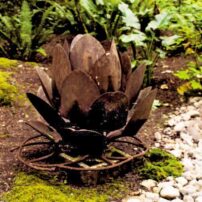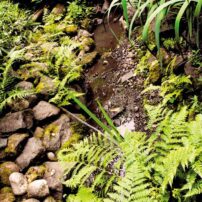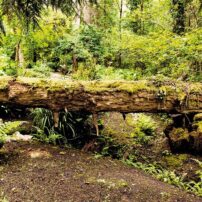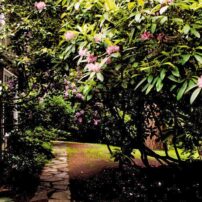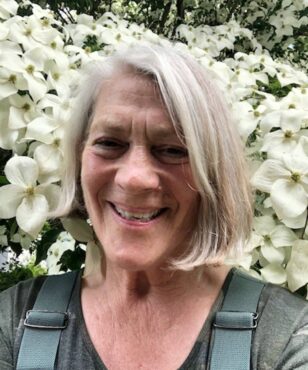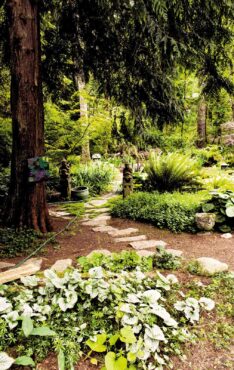 Raymond and Rosemary Nye have created a unique garden in a potentially problematic location. The property, located in the southwestern area of Bainbridge Island, features numerous springs that create boggy, marshy conditions, making it difficult, at best, for traditional gardening. Additionally, heavy rains cause the formation of intermittent streams. These streams empty into Fletcher Bay, which in turn opens to Puget Sound. This runoff water carries with it silt from the native soil, changing the environmental conditions at the outflow.
Raymond and Rosemary Nye have created a unique garden in a potentially problematic location. The property, located in the southwestern area of Bainbridge Island, features numerous springs that create boggy, marshy conditions, making it difficult, at best, for traditional gardening. Additionally, heavy rains cause the formation of intermittent streams. These streams empty into Fletcher Bay, which in turn opens to Puget Sound. This runoff water carries with it silt from the native soil, changing the environmental conditions at the outflow.
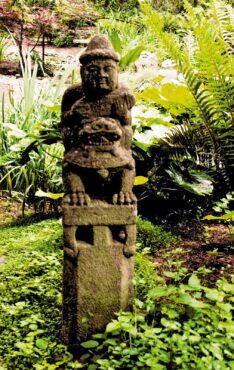 The couple were retired from government-related careers, and their concern was to address the wetland part of their property. The Nyes had noticed that development and construction upstream were increasing the quantity of silt carried by these intermittent streams. Aware of the adverse effects caused by this siltation, they set out to create a garden that inhibits the downslope movement of silt.
The couple were retired from government-related careers, and their concern was to address the wetland part of their property. The Nyes had noticed that development and construction upstream were increasing the quantity of silt carried by these intermittent streams. Aware of the adverse effects caused by this siltation, they set out to create a garden that inhibits the downslope movement of silt.
By retaining silt-laden water for absorption on site, like a rain garden concept, their goal was to decrease downstream flow, thereby reducing the movement of potential pollutants. With the implementation of this design idea, they have developed a fascinating shady garden with unique features.

European blackberry and other undesirable plants had to be removed from the boggy areas. Well-behaved natives remained, including sword ferns, skunk cabbage and salmonberry. Fallen logs were left in place, some of which have become nurse logs, hosting deciduous red huckleberry plants. Trees remained, including red alder, western red cedar, western hemlock and dogwood. Those with low-hanging limbs were pruned up to create a brighter, more open space.
A serpentine stream bed was dug and lined with river rock from the couple’s property in the Cascade Mountains. They placed rounded stones strategically to emulate a natural stream bed. The winding channel created a path for runoff, allowing water to remain in place for a longer period. As the soil reabsorbs water, suspended silt particles are retained in the rocky streambed, reducing the amount that moves toward the bay.
Several bridges lead the bark-covered walkway across the stream bed. Shade-loving ground covers fill in gaps between flagstone and pavers. Seating of various types along the pathway presents an invitation to stop, sit and enjoy.
 Augmenting the native plants are specially selected ferns. Large clumps of yellow-blooming flags border the stream bed. The glossy foliage of calla lilies reflects the filtered light. Many plantings of podophyllum species display their large, umbrella-like leaves, protecting the flowers beneath them. Bergenia thrives in the shaded, moist location.
Augmenting the native plants are specially selected ferns. Large clumps of yellow-blooming flags border the stream bed. The glossy foliage of calla lilies reflects the filtered light. Many plantings of podophyllum species display their large, umbrella-like leaves, protecting the flowers beneath them. Bergenia thrives in the shaded, moist location.
Numerous plantings of large-leaved Darmera peltata provide continuity. The golden-green color of Japanese forest grass borders the stream bed, creating visual interest. While not all native to this area, the plant selections are ideally suited for this environment, complementing the lush, moist atmosphere of this shaded woodland.
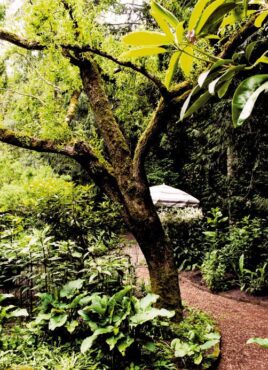 A large corkscrew willow, beautifully shaped, is surrounded by many younger willows. These saplings were cuttings from the mother tree and simply placed into the moist ground, where they have taken root.
A large corkscrew willow, beautifully shaped, is surrounded by many younger willows. These saplings were cuttings from the mother tree and simply placed into the moist ground, where they have taken root.
Eighteen Japanese maples have been added to the garden, along with many varieties of hosta. A native rose extends 10 feet in height. Stakes and netting protect these and other tasty plants from nibbling deer.
Pottery and garden art have been thoughtfully placed. A large, metal lotus flower, permanently in bud, was created from shovel heads by Raymond Nye. Farther along the path, a metal sculpture of a prickly pear cactus defies the shady, moist location. Many other pieces are placed along the stream and pathways to be appreciated by the viewer.
Several sculpted herons are situated where a real heron might be seen. An oversized dragonfly hovers over a leopard plant. Nearby, a large pottery fish seems to have escaped the stream, and a toad hides in the vegetation. Many of the art pieces evoke an Asian theme.
 Rosemary Nye is drawn to special ceramic pottery, often quite large in scale. She has frequently called home with the message, “Ray, bring the truck!” — meaning she has found an item, probably large, but most definitely unique.
Rosemary Nye is drawn to special ceramic pottery, often quite large in scale. She has frequently called home with the message, “Ray, bring the truck!” — meaning she has found an item, probably large, but most definitely unique.
The Nyes purchased their 2-acre property in 1976. The existing home included wood from western red cedar harvested on site. Landscaping around the home contains rhododendrons, both native and cultivated varieties. Lawn stretches between borders that are punctuated by mature Douglas fir and western hemlock. Many of the trees are limbed up, providing substantial light for perennials.
Along the gravel driveway, a split-rail fence supports a selection of Oriental poppies, peonies and lilies, creating a lovely border. A large Douglas fir hosts a climbing hydrangea, which extends at least 30 feet up the trunk. Ground-cover plants and various mosses are welcome in the lawns.
 The on-site grove of cedars used in building the house had been growing in a shallow depression. When the remnants were cleared away, Raymond Nye excavated the site to create an 8-foot-deep pond. This was lined with river rock and has become a lovely feature of the property. The pond has been used as a swimming hole but is now home to goldfish and trout when eagles, raccoons and river otters don’t visit it. Water lilies thrive in a section of the pond.
The on-site grove of cedars used in building the house had been growing in a shallow depression. When the remnants were cleared away, Raymond Nye excavated the site to create an 8-foot-deep pond. This was lined with river rock and has become a lovely feature of the property. The pond has been used as a swimming hole but is now home to goldfish and trout when eagles, raccoons and river otters don’t visit it. Water lilies thrive in a section of the pond.
At the edge of the water feature is an elevated tea house, providing a viewing spot. On a wall hangs a carved, wooden, shuttered window that’s over a century old. Rosemary Nye acquired it during a visit to Nepal when she discovered these antiques were being used as firewood. It’s another thoughtful addition to the larger garden.
 Irrigation, where necessary, is performed manually using a hose. Gardeners do assist twice a year with mulching and pruning. Trapped silt, leaves and needles from the conifers are periodically removed from the stream bed, which Raymond Nye cares for. Rosemary Nye is involved with fundraisers for PEO through plant sales and has hosted open gardens to raise money for the organization’s scholarship program.
Irrigation, where necessary, is performed manually using a hose. Gardeners do assist twice a year with mulching and pruning. Trapped silt, leaves and needles from the conifers are periodically removed from the stream bed, which Raymond Nye cares for. Rosemary Nye is involved with fundraisers for PEO through plant sales and has hosted open gardens to raise money for the organization’s scholarship program.
The Nyes have implemented a creative idea, which is a fantastic addition to the location. A bog is hard to observe and enjoy due to its soft, mucky soil, and can be difficult to walk through without disturbing the plants. Since the pathways are raised above the stream flow, it’s easy to walk, observe and enjoy. A challenging problem has met with two creative minds, and the result is praiseworthy.




